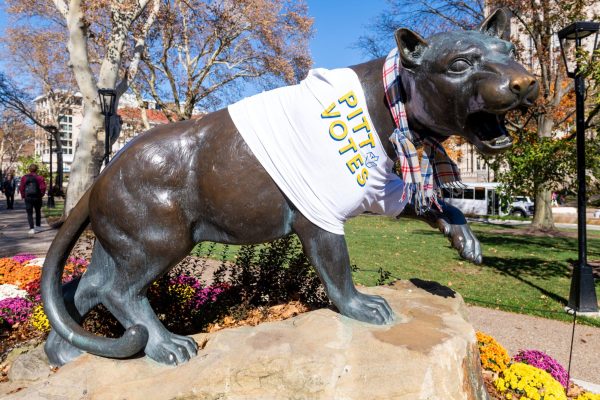Research team examines role of colors in nature
October 1, 2012
From purple flowers to red spiders to yellow penguin feathers, a tremendous diversity of colors…
Nishant Singh | Staff Photographer
From purple flowers to red spiders to yellow penguin feathers, a tremendous diversity of colors marks the natural world, and a group of Pitt students wants to know why.
Working together under the direction of Nathan Morehouse, an assistant professor in the Department of Biological Sciences who arrived at Pitt just last year, eight undergraduate biology enthusiasts are testing ideas as to the roles that color might play in the wild.
“We study the use of color in the animal kingdom,” Morehouse said. “That takes us a lot of different places.”
One of those places is the realm of butterflies. Along with fellow students Cassandra Bartoch and Ely Luna, senior ecology and evolution major Natalie Roberts focuses her attention on the Pieris rapae, or the cabbage white butterfly.
Not unlike the intrigue that overcomes TV watchers wondering which strapping lad “the bachelorette” will pick, the mating decisions of the female cabbage white fascinates Roberts. She wants to figure out if females use color to decide which male suitor would provide offspring with the best chance of survival.
She’s interested for two reasons: In this species, males with greater nutrition have more colorful wings, and males contribute to offspring by giving nutrients in addition to genetic material (unlike human sperm, which only deals in genes). The question becomes whether the more colorful males produce more nutrient-rich “spermatophores,” or mating packages.
“We’re going to see if males that have more, give more,” Roberts said. To answer that question, Roberts and others have bred thousands of male caterpillars on special diets with differing levels of an essential nutrient protein, allowed them to metamorphasize into butterflies and produce spermatophores and then dissected out the spermatophores one by one.
As she’s currently assaying the packages’ protein content, she’s anxiously awaiting an answer. “In science, you can discover stuff that nobody else knows, which is really exciting to me,” Roberts said.
An excitement about color and mating behavior does not uniquely apply to Roberts, at least in the Morehouse lab. On the contrary, juniors Em Maier and Kevin Byrne want to learn how color could influence certain female spiders’ decisions to mate with males in the vicinity as opposed to another common response — eating them.
The specific spiders under investigation, part of the Salticidae family of “jumping spiders,” feature males with a splash of red on their faces, and prior results in the lab have demonstrated that this red coloration can actually help prevent males from being devoured. But Maier and Byrne want to probe the mechanism, which they suspect might have to do with learning and memory.
“We’re trying to see if [female] jumping spiders can learn to avoid certain colors,” Byrne said. “And we’re going to see if they can take that knowledge that they learned about the colors and transfer it to another aspect of their life — from foraging for food to mate choice.”
To find out whether the spiders show this memory “spill-over effect,” Maier and Byrne are trying to produce what psychologists might call a conditioned taste aversion. First they develop two types of the same red-colored prey, milkweed bugs: one that eats toxic, distasteful milkweed seeds and another that eats neutral sunflower seeds.
Then they feed the toxic and neutral milkweed bugs to two groups of female spiders, and at the right moment, they set up romantic encounters with red-faced males in petri dishes equipped with video cameras. If their experience with toxic milkweed bugs reduces the female spiders’ tendency to treat males as prey, then the females have learned something about the color red, so the thinking goes.
With one round of males and females having already met and several more rounds planned, Byrne looks forward to analyzing the videos.
“When you put a certain amount of work into something and finally get that result, it’s that much more rewarding,” he said.
As important as color might be for the sexual reproduction dances of insects and arachnids, so too is it for flowering plants. Working with Morehouse and biological sciences professor Susan Kalisz, biology majors Ashley O’Connor and Irtaza Asar want to know how petal coloration could influence a flower’s attractiveness to the eyes of pollinators, such as bees.
The subject is Collinsia heterophylla, a purple-and-white flowering plant known as Chinese Houses. O’Connor and Asar are spending the semester in close contact with four different populations of heterophylla from four counties in California, each population bearing unique purple hues.
“Why would a flower produce so much variation?” O’Connor said, though with a guess in mind. “I think it’s going to really be the contrast between the background environment and the flower that’s going to make a difference for pollinators.”
To test that hypothesis, O’Connor and Asar have sequentially measured flower petals with a light spectrometer. The spectrometer shines different wavelengths of light onto an object and then measures which wavelengths bounce off and which ones the object absorbs.
In the heterophylla’s case, the students have chosen 10 standard spots on the petal to shine light, and based on the light that bounces off, they hope to generate descriptive reflection patterns for each of the four plant populations.
With these patterns determined, the Morehouse lab will then use math to guess at what the most attractive pattern might look like from a bee’s point of view. Collaborating with a professorial counterpart at the Free University of Berlin in Germany, Morehouse has access to troves of data about the visual sensitivity of several pollinator species. Morehouse hopes to build from this data mathematical models of the pollinators’ visual systems and then plug O’Connor and Asar’s flower patterns into the models.
The anticipated result? Real insight into why bees decide to approach one flower over another.
Even with the finish line still ahead, Asar is proud of what his team has accomplished so far.
“We’ve made so much progress that we’re actually looking to get published,” Asar said.
For students in the Morehouse lab, investigating color’s role in nature entails more than just collecting data for publication. On the one hand, given the distribution of research specimens across refrigerators, greenhouses and other facilities in every corner of the Crawford-Langley-Clapp complex, “there’s a lot of walking involved,” Asar said.
Daily exercise aside, students also talk of community bonding. From attending rugby games to art exhibits to zombie museums, the Morehouse lab makes a point of interacting outside of work hours.
“We’re serious when we need to be, but we can have a lot of fun too,” Bartoch said. “I think we’re a very close lab, and I love that about us.”
This feeling of community helps motivate the undergraduate researchers, including junior Zarreen Amin, who contributes to a separate project in the Morehouse lab.
“I’m not just doing it for me,” she said. “I’m doing it for other people, too.”
Where the lab fosters a sense of belonging with others, it does the same toward nature.
“One of the tragedies of modern culture is that we lack meaningful interaction with living things,” Morehouse said, contrasting outside realities with his agenda for students in the lab. “I hope to inspire them to take a closer and hopefully longer look at the natural world. I want them to find biology is their home.”
Students seem to have gotten the message.
“Just because it’s not human doesn’t make it unimportant,” Roberts said, referring to her butterfly research. “It’s part of the natural world. We think we’re something above that, but we’re just a part of it.”
In the Morehouse lab, accomplishing oneness with nature happens alongside building an appreciation for the scientific process.
“It’s like being lost in a forest and trying to find your way out,” Asar said. “It’s really the most genuine way of living.”
O’Connor takes the sentiment further, framing the cause for ecological research in existential terms. “If we decide to stop asking questions ‘why,’ then how can we possibly evolve?”
Editor’s note: Em Maier is an employee of The Pitt News.








